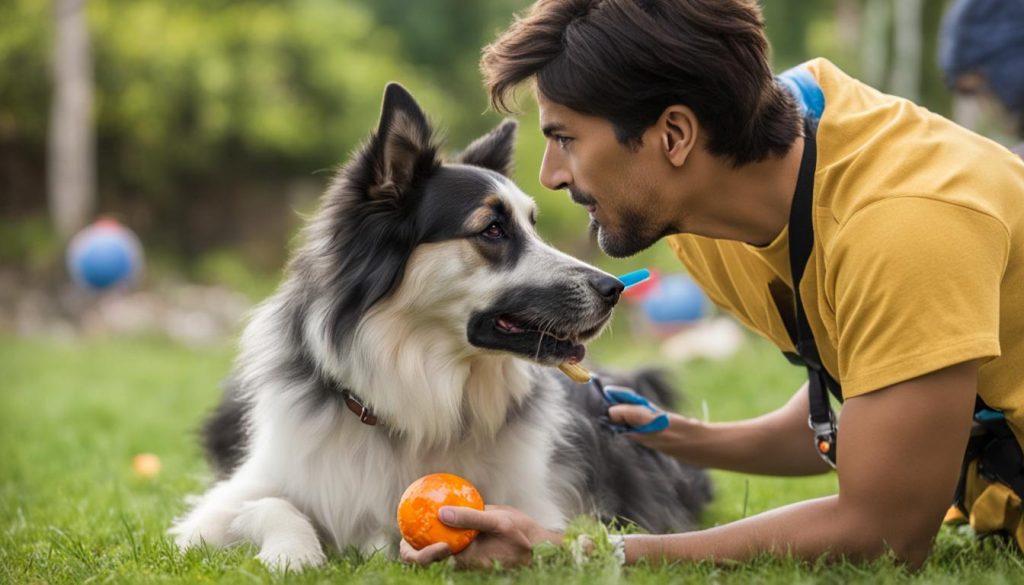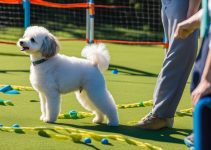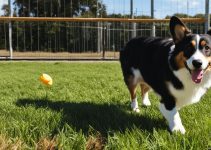Teaching a dog their name sets a foundation for obedience training and ensures they respond to your call, which is a legal requirement to maintain control. This guide provides a step-by-step process for teaching your dog to recognize their name, beginning with attention and focus exercises that reward their response with treats or play.
With time and patience, your dog will learn to look at you upon hearing their name, paving the way for successful obedience training.
How to Teach a Dog Their Name
- Name recognition is an essential first step in obedience training for dogs.
- Training should commence in a calm, distraction-free environment to optimize focus.
- Use positive reinforcement, such as treats or praise, to associate the dog’s name with rewards.
- Marker words or clickers can be used to signal correct responses and reinforce desired behavior.
- Consistency and repetition are crucial in solidifying name recognition in your dog’s mind.
- Gradually introduce distractions to test and strengthen your dog’s response to their name.
- Adjust and adapt training methods based on your dog’s response as they become more proficient.
The Importance of Teaching Your Dog to Recognize Their Name
Teaching a dog to recognize their name is a pivotal step in ensuring their attention for further obedience training. Dogs do not come pre-programmed with name recognition and thus, associating their name with positive reinforcement like treats or play is paramount. Establishing this recognition takes consistent effort, but leads to a dog that is not only attentive but also more controllable both at home and in public spaces, effectively reducing distracting behavior.
Having a dog that recognizes its name brings a myriad of benefits. A well-trained and responsive dog is far more enjoyable to be around, as it understands and follows commands readily. This not only improves your pet’s overall behavior but also enhances the bond between you and your furry companion.
Furthermore, a dog who knows its name is easier to manage in public places, making it more approachable and less frightening for those who may be apprehensive around unfamiliar animals.
Another crucial aspect to teaching name recognition is the foundation it sets for future training. When a dog responds reliably to its name, it becomes considerably easier to teach new commands and skills. As your dog’s trust in you grows, so will its eagerness to learn and please you, creating a positive and fulfilling partnership.
In conclusion, dedicating time and effort to teach your dog to recognize its name is an essential investment for any dog owner. Not only does it lead to a more attentive and well-behaved pet, but it also lays the groundwork for a lasting, rewarding relationship between you and your dog, as well as other people and animals your pet may encounter.
Preparations Before the Training Begins
Before starting the journey of teaching your dog to recognize their name, it’s vital to get everything in place to ensure the process goes smoothly. This includes creating an appropriate environment for dog name training and making sure you have a variety of treats and rewards on hand.
Creating a Distraction-Free Environment
An essential aspect of training your dog’s name is to start in an environment free from distractions to facilitate focus and learning. This controlled setting is a precursor to successful training and allows for an undistracted connection between you and your dog, making the learning process more efficient.
Keep in mind that distractions don’t have to be loud noises or external disturbances; removing toys, other pets, or anything that might take your dog’s attention away from you is equally important.
Gearing Up with Treats and Rewards
Having a variety of treats on hand to use as rewards during name training sessions can help create a strong positive association with their name for your dog. Soft, easily chewable treats and food rewards are suggested to keep the dog motivated and reinforce desired behaviors promptly.
Keep in mind that your choice of treats can significantly impact the success of your pet name recognition training. It’s crucial to select treats that your dog finds highly motivating and appealing. Experiment with a range of treats to find out what works best for your canine companion – some dogs prefer small pieces of cooked chicken or cheese, while others can’t resist a peanut butter-filled treat.
As the training progresses, you can start to introduce different types of rewards such as play, praise, or even their favorite toy. The ultimate goal is to help you and your pet establish a stronger bond and learn to work together through positive reinforcement techniques.
The Role of Positive Reinforcement in Name Recognition
Positive reinforcement is a crucial element in training a dog to recognize its name. This method involves rewarding the dog immediately after they look at you when their name is called. Such reinforcements can be through treats, praise, or play. The use of a marker word or a clicker to signal the correct response before giving the reward strengthens the learning process.

When training your dog to respond to their name, consistency is key. By providing a treat, praise, or playtime every time your dog exhibits the desired behavior, you reinforce their association between their name and a positive consequence. As a result, your dog will be more motivated to respond to their name going forward.
Integrating marker words or clickers in the training process is an effective way to enhance your dog’s understanding of what you expect them to do. By using a marker word like “yes” or a clicker noise to signal that they have exhibited the desired behavior, your dog will better comprehend the connection between their name and the reward.
Ultimately, combining positive reinforcement with marker words or clickers will expedite the learning process and ensure that your dog understands the importance of paying attention when their name is called. With patience and practice, your dog will become more attentive and responsive both in and out of training sessions.
Step-by-Step Name Training Technique
Training your dog to recognize their name is a rewarding process that requires patience and dedication. A step-by-step approach with consistent positive reinforcement will help your pet develop a strong connection between their name and your call for attention.

1. Getting Your Dog’s Attention
Begin the name training by waiting for a moment when your dog is not already looking at you. Then, say their name in a happy tone. As soon as they give you their attention, mark this behavior positively.
2. Using Marker Words or Clickers
Employ the use of marker words, such as “yes,” or a clicker in your training sessions. These tools help signal to your dog that they are performing the desired behavior, which is paying attention to you when their name is spoken. This method of training with clickers or marker words will facilitate better communication and understanding between you and your pet.
3. Reinforcing Attention with Treats and Praise
Timely and consistent reinforcement is crucial when training your dog’s name recognition. Use treats and praise immediately when the dog responds to their name. Keep in mind to avoid asking the dog to sit or perform other behaviors during this process, as the focus should be on reinforcing the act of giving attention upon hearing their name.
With patience, consistency, and dedication to the step-by-step name training technique, your beloved pet will respond attentively to their name in no time. Remember, positive reinforcement is the key to a successful and enjoyable learning experience for both you and your dog.
Playing the Name Game to Reinforce Learning
Continuously practicing the name game is essential to reinforce your dog’s name recognition effectively. By calling your dog’s name unexpectedly and rewarding them for responding, you provide an engaging exercise that maintains their interest. This game can be easily integrated into your daily routines, thus marking your dog’s attentive response each time and establishing a solid name recognition over time.
To play the name game, start by being in your dog’s line of sight but not actively engaging with them. Casually and unexpectedly say their name, and the moment they look at you, mark the behavior positively using a marker word or a clicker. Immediately follow up with a treat, praise, or playtime to reinforce the positive behavior. Using various rewards can keep your dog motivated and focused on responding to their name.
Consistently playing the name game throughout different times of the day and in different environments strengthens your dog’s name recognition ability. As your dog becomes more adept at the game, gradually increase the distance and introduce a controlled amount of distractions to challenge them further. Remember, the key objective is to make the game fun and rewarding for your dog, and this, in turn, will effectively reinforce their learning.
Introducing Controlled Distractions to Test Training
As your dog becomes more proficient with name recognition in a distraction-free environment, it’s essential to introduce controlled distractions to strengthen their ability to respond to their name in various situations. Gradually increase the level of distractions while maintaining a high value of reinforcement to keep your dog’s attention.
Incrementally Increasing Distractions
Begin by introducing manageable distractions and slowly build from there. For example, start with familiar noises like a TV or music playing, then progress to more challenging distractions such as other people, pets, or outdoor environments. Throughout this process, ensure that the value of the rewards remains high enough to maintain your dog’s attention and motivation during training.
Assessing Your Dog’s Response to Distraction
It’s crucial to monitor your dog’s response to increased distractions and adjust your training methods accordingly. If they fail to respond when their name is called, take a step back to a less distracting environment and reinforce their positive behavior before trying again with more distractions.
Maintaining patience and adjusting the value of rewards plays a key role in this adaptive training process. Regularly assess your dog’s progress in various environments and situations, refining your approach as needed to ensure success in their dog obedience training.
In conclusion, training your dog to respond to their name reliably amidst distractions is a vital component of comprehensive dog training. By incrementally increasing distractions and closely monitoring your dog’s response, you can tailor your approach to suit their individual needs, ultimately fostering a stronger connection and heightened responsiveness in a myriad of situations.
Ensuring Consistency and Repetition in Training
One of the most vital factors in successfully teaching a dog name recognition is consistency and repetition. It is essential to conduct brief and frequent training sessions throughout the day to ensure the dog consistently responds to their name. The saying, “practice makes perfect,” holds true for dog training as well. Regular practice reinforces the association between their name and the reward, making it more reliable.
Though treats are an effective form of positive reinforcement during the initial phases of training, it’s essential to gradually phase them out. As your dog becomes more reliable in responding to their name, begin to introduce verbal praise and affection. This transition helps keep your dog motivated by making their accomplishments even more rewarding and fosters a positive relationship between you and your pet.
Remember that every dog learns at a different pace and be patient during the process. When you maintain consistency and repetition in training, you are laying the foundation for successful name recognition and, ultimately, a well-trained and obedient dog.
READ: Effective Strategies: How to Stop Dog Begging
Conclusion
In conclusion, teaching a dog to recognize their name effectively is a process that requires patience, consistency, and the use of positive reinforcement. Utilizing a step-by-step approach that accounts for distractions and emphasizes repetition helps ensure success in the training process. The ultimate goal is to establish a strong and dependable recall, which will enable your dog to be more attentive and responsive in various environments and situations.
As your dog progresses in their training, it becomes important to maintain consistency in their training sessions and to be patient as the process unfolds. Through systematic reinforcement of the desired behaviors and gradual exposure to increasing levels of distractions, your dog will become more reliable in responding to their name when called.
Remember to gradually phase out treat-based reinforcements and introduce verbal praise and affection as your dog’s response becomes more solid and reliable. This way, your dog will learn to respond to their name not only for the prospect of treats but also due to the positive bond they share with you, their owner. Ultimately, successfully teaching your dog their name will empower you and your pet to safely navigate and enjoy a variety of environments and situations together.
FAQ
How does teaching a dog their name help with obedience training?
Teaching a dog their name sets a foundation for obedience training and ensures that they respond to your call, which is essential for maintaining control and reducing distracting behavior.
What is the importance of using a distraction-free environment during name training?
A distraction-free environment facilitates focus and learning, allowing for an undistracted connection between you and your dog, making the learning process more efficient.
Can you explain the role of positive reinforcement in teaching a dog their name?
Positive reinforcement is a crucial element in training a dog to recognize its name, and it involves rewarding the dog immediately after they look at you when their name is called. These reinforcements can be through treats, praise, or play, helping create a strong positive association with their name.
How to use marker words or clickers in the name training process?
Use a marker word such as “yes” or a clicker to signal to your dog that they are performing the desired behavior, which is paying attention to you when their name is spoken. This helps to strengthen the learning process.
What is the role of consistency and repetition in teaching a dog their name?
Consistency and repetition are essential in ensuring that a dog consistently responds to their name. Regular training sessions, both brief and throughout the day, help establish a solid recognition and a reliable recall over time.
How can controlled distractions be introduced to test a dog’s name recognition?
To introduce controlled distractions, gradually increase the level of distractions during training, and adjust the value of reinforcement to maintain the dog’s attention. If the dog fails to respond, take a step back to a less distracting environment before trying again with more distractions.






